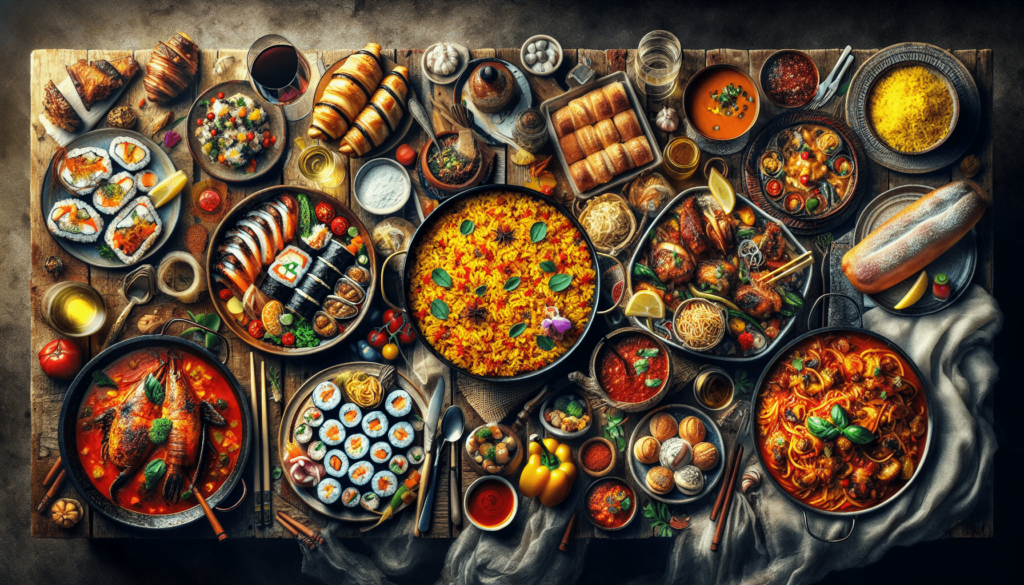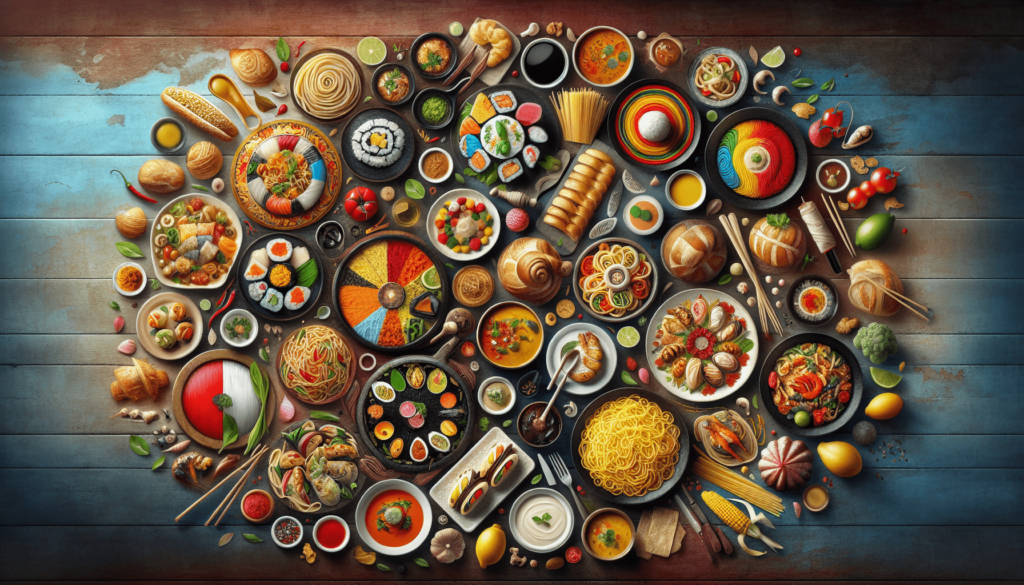Imagine embarking on a culinary journey that takes you from the bustling street food corners of Bangkok to the sophisticated dining rooms of Paris. “The Hungry Nomad: Exploring global cuisines” is your passport to understanding the rich tapestry of global food traditions. You’ll delve into the historical roots of beloved dishes, uncover current culinary trends that are capturing the world’s attention, and gain insights into the way food shapes cultures and societies.
This article promises an eclectic mix of stories, case studies, and expert analysis, making it an essential read for anyone eager to enrich their palate and broaden their culinary horizons. Join in as we explore the limitless and mouthwatering possibilities that the world’s kitchens have to offer, sparking your curiosity and appetite along the way. Have you ever wondered what it would be like to traverse the globe using just your taste buds, savoring the essence of different cultures one plate at a time?
Table of Contents
The Hungry Nomad: Exploring Global Cuisines
Overview
The world is a grand symphony of flavors, where culinary traditions offer deep insights into the history, geography, and culture of each region. As the “Hungry Nomad,” you’re about to embark on an enriching journey exploring global cuisines, learning not just about food but also the stories, people, and heritage behind every dish. This exploration is timely, given the increasing global interconnectedness and the universal quest for culinary adventures.
Thesis Statement
In this comprehensive guide, we’ll voyage through the varied and vibrant world of global cuisines, illuminating how different cultures have shaped their food traditions and how these traditions continue to evolve. Understanding global cuisines offers more than just gastronomic pleasure; it fosters cultural appreciation and a sense of global community.
Historical Context
The story of global cuisines is as ancient as human history itself. From the ancient spice routes that connected the East and West to the migration waves that carried culinary traditions across continents, the history of food is the history of mankind. Secondary keywords like “ancient spices” and “culinary migration” are essential in grasping this historical journey.
Ancient Spice Routes
The ancient spice routes were the arteries of early trade between civilizations. Spices like cinnamon, pepper, and cloves were not only valuable for flavoring food but were also essential for preserving it. These aromatic treasures traveled from Asia to Europe, influencing dishes, dietary habits, and even economies.
Culinary Migration
Migration has profoundly impacted global cuisines. For example, the introduction of New World crops such as potatoes, tomatoes, and maize into Europe transformed traditional European dishes. Similarly, African slaves brought their cooking techniques and preferences, which heavily influenced American Southern cuisine.
Current Trends
Today’s global culinary landscape is a fascinating blend of tradition and innovation. Keywords like “fusion cuisine,” “farm-to-table,” and “sustainable eating” dominate the current trends, reflecting society’s growing interest in ethical and health-conscious eating habits.
Fusion Cuisine
Fusion cuisine combines elements from different culinary traditions, creating a symphony of flavors that is both familiar and novel. Sushi burritos, kimchi tacos, and curry pizzas are just some examples that illustrate the exciting culinary innovation happening right now.
Farm-to-Table Movement
The farm-to-table movement emphasizes locally sourced, organic ingredients, ensuring that food travels shorter distances from farm to plate. This not only supports local farmers but also reduces the environmental impact of food transportation.
Sustainable Eating
Sustainable eating emphasizes the consumption of food that is healthful to our bodies and the planet. This includes reducing meat consumption, supporting sustainable seafood, and minimizing food waste.
Key Concepts and Definitions
Understanding some basic culinary terms will enrich your global cuisine exploration. Keywords like “umami,” “terroir,” and “mise en place” are essential in culinary conversations.
Umami
Umami, often described as the fifth taste, is a savory flavor found in foods rich in glutamate, like soy sauce, cheese, and mushrooms. It adds depth and complexity to dishes.
Terroir
Terroir refers to how a region’s climate, soil, and landscape affect the taste of food. It’s a concept often discussed in the context of wine but is also relevant to cheese, coffee, and other artisanal products.
Mise en Place
Mise en place translates to “everything in its place.” It refers to the practice of organizing and prepping ingredients before cooking, essential for efficient kitchen work.
Detailed Exploration
Now, let’s dive deeper into specific global cuisines, examining their unique attributes and cultural significance. Our journey will cover several geographic regions, each having its own distinct culinary identity.
Asian Cuisines
Asia is a treasure trove of diverse culinary practices. Let’s look at two standout examples: Japanese and Indian cuisines.
Japanese Cuisine
Japanese cuisine is renowned for its simplicity, precision, and seasonal ingredients. Dishes like sushi and sashimi exemplify the importance of fresh, high-quality ingredients.
Key Ingredients: Rice, soy sauce, fish, seaweed Signature Dishes: Sushi, sashimi, ramen, tempura
Indian Cuisine
India offers an aromatic adventure with its use of spices. Indian cuisine is also known for its regional diversity—North Indian dishes often feature bread and meats, while South Indian cuisine is characterized by rice and vegetarian fare.
Key Ingredients: Basmati rice, lentils, spices (cumin, coriander, turmeric) Signature Dishes: Butter chicken, biryani, dosas, samosas
European Cuisines
Europe’s culinary landscape is rich and varied. We’ll explore the rich pasta traditions of Italy and the hearty, rustic dishes of France.
Italian Cuisine
Italian cuisine celebrates simplicity, reliant on high-quality ingredients and traditional techniques. Pasta, olive oil, and tomatoes form the backbone of Italian dishes.
Key Ingredients: Olive oil, garlic, pasta, tomatoes Signature Dishes: Spaghetti carbonara, lasagna, risotto, pizza
French Cuisine
French cuisine is synonymous with fine dining. It places a premium on technique and presentation, with a focus on rich, flavorful sauces and impeccable pastries.
Key Ingredients: Butter, wine, cream, bread Signature Dishes: Coq au vin, ratatouille, croissants, baguette
African Cuisines
Africa’s culinary traditions are diverse, reflecting its rich cultural heritage. We’ll delve into Moroccan and Ethiopian cuisines as representatives of North and East Africa, respectively.
Moroccan Cuisine
Moroccan cuisine is a bustling bazaar of flavors, seamlessly blending sweet and savory. Tagine, a slow-cooked stew, epitomizes the layered flavors and use of spices prevalent in Moroccan dishes.
Key Ingredients: Couscous, lamb, spices (cumin, coriander, saffron), dried fruits Signature Dishes: Tagine, couscous, harira
Ethiopian Cuisine
Ethiopian cuisine is communal, often enjoyed on a large platter called a mesob. Injera, a sourdough flatbread, serves as both plate and utensil, scooping up flavorful stews known as wats.
Key Ingredients: Teff flour, lentils, spices (berbere, mitmita), meat Signature Dishes: Doro wat, injera, tibs
Example 1: The Global Influence of Spices
A fascinating case study revolves around the global influence of spices. Spices like black pepper, cinnamon, and cloves fundamentally changed cooking techniques and flavor profiles across the world. The Portuguese and Dutch maritime explorations were initially driven by the quest for these coveted flavorings, and their subsequent control over spice trade routes led to the dissemination of spice-rich culinary traditions to new regions.
Example 2: The Italian American Cuisine
The Italian American culinary experience presents another compelling case study. Italian immigrants in the United States adapted their traditional dishes to accommodate available ingredients, resulting in a new, hybrid cuisine. Iconic dishes such as spaghetti and meatballs and New York-style pizza were born out of this cultural fusion.
Comparison of Different Perspectives
Different cultures have their unique approaches to similar culinary challenges, such as preserving food or creating celebratory dishes. In Europe, drying and smoking were crucial preservation methods, while in Asia, fermentation was widely practiced. Both techniques highlight the ingenuity and resourcefulness in addressing food preservation.
Preservation Techniques Comparison Table:
| Culture | Techniques | Key Ingredients Used |
|---|---|---|
| European | Drying, Smoking | Meat, Fish, Herbs |
| Asian | Fermentation | Vegetables, Soybeans |
Impact Assessment
These varying methods have had differing impacts on culinary traditions. European smoking techniques imparted a distinctive flavor to meats that became central to numerous dishes. Asian fermentation contributed to the development of complex, umami-rich flavors, now celebrated in global gourmet circles.
Future Directions and Implications
What does the future hold for global cuisines? If the current trends are any indication, the emphasis will likely be on sustainability, health, and technological integration.
Predictions
Expect more plant-based innovations and lab-grown meat products as society strives for sustainable food solutions. Technology, such as AI in cooking, will likely play a more significant role, offering customized nutrition plans based on individual health data.
Implications
These advancements will profoundly impact not only the food industry but also societal norms and individual lifestyles. A greater emphasis on sustainability and health-conscious eating can contribute to improved overall wellness and a reduced environmental footprint.
Conclusion
Recap
In this article, we’ve traversed the delicious landscapes of global cuisines, uncovering how history, culture, and innovation shape what we eat today. From the rich, creamy sauces of French cuisine to the spicy, aromatic stews of Ethiopian cooking, each bite tells a story.
Final Thought
As you continue your culinary explorations, remember that every dish is an invitation to understand and appreciate a different part of the world. What global cuisine will you explore next?

Engagement
Share your food adventures in the comments below or use the hashtag #HungryNomad on social media! Want to dive deeper? Explore more resources and culinary histories—each dish you encounter is a new story waiting to be told.

Credible Sources
- “Food: A Culinary History,” by Jean-Louis Flandrin and Massimo Montanari
- “The Oxford Companion to Food,” by Alan Davidson
- “On Food and Cooking: The Science and Lore of the Kitchen,” by Harold McGee
- National Geographic’s Food Journeys of a Lifetime: 500 Extraordinary Places to Eat Around the Globe
- “Culinary Cultures of Europe: Identity, Diversity and Dialogue,” by Darra Goldstein and Kathrin Merkle
Your journey as a Hungry Nomad has just begun. Bon appétit!
